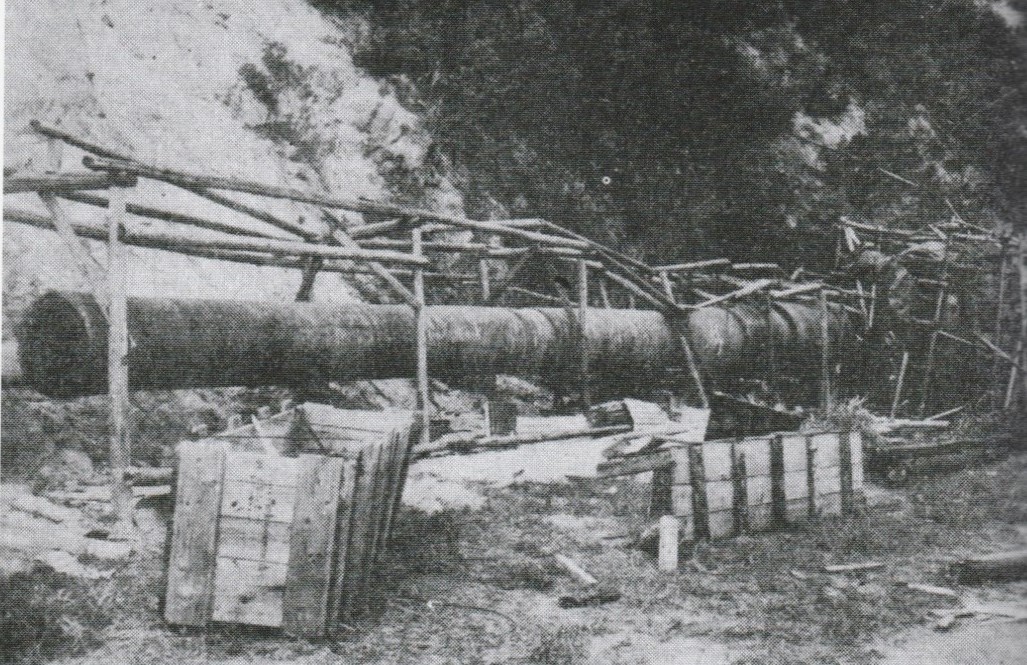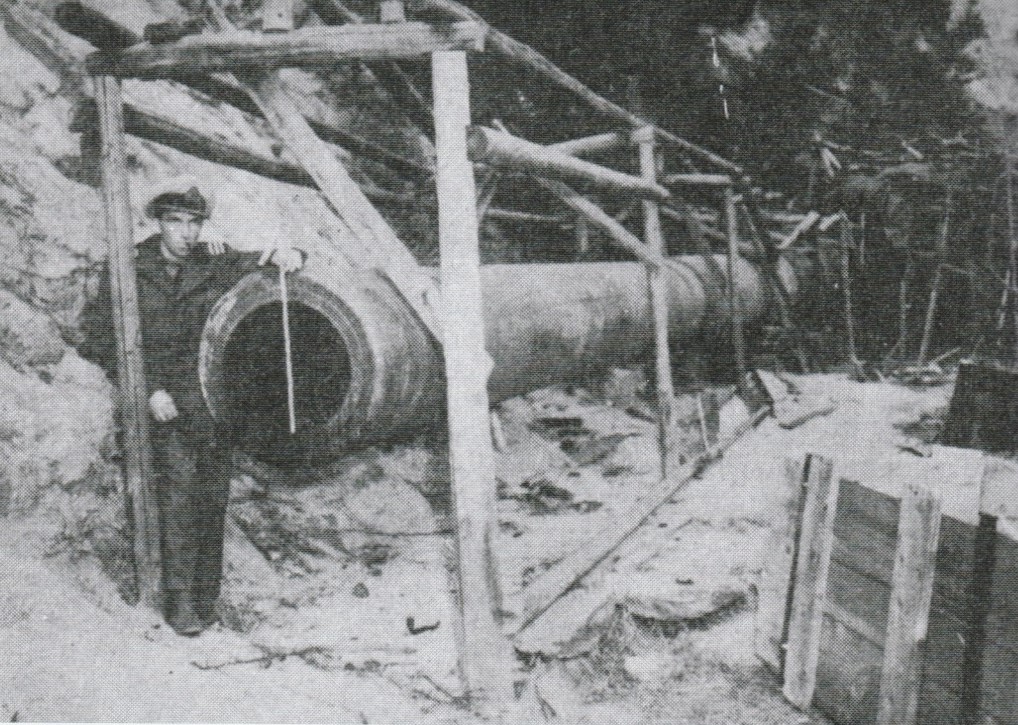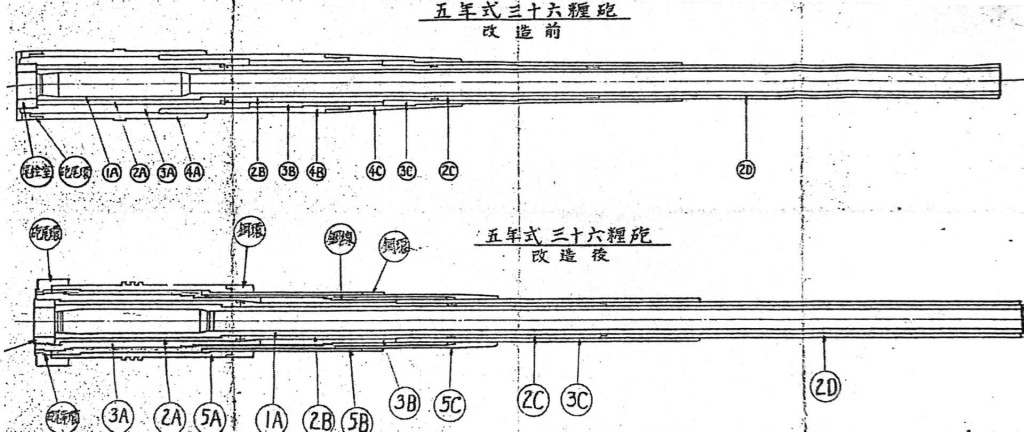

This was an experimental gun begun shortly after the end of World War I and is sometimes confused with the 46 cm/50 (18.1") 5th Year Type. Most Western sources say that two prototypes were produced at the Kure Navy Yard, but Japanese sources say that there was only a single gun which split during test firing in 1920 but was later repaired. Work on the project was halted by the Japanese signing of the Washington Naval Limitation Treaty in 1922 which prohibited large-caliber weapons. The project was restarted in November 1935 and the gun was repaired for testing the protection system of what became the Yamato class battleships. The first test firings for the repaired gun started in 1936.
The design history of this weapon is somewhat complicated. Before the 46 cm/50 5th Year Type was chosen as the largest gun to be mounted in "Eight-Eight-Fleet" battleships, the Imperial Japanese Navy Technical Department ordered the Kure Naval Arsenal to make a 48 cm prototype. In an attempt to hide its true caliber, the prototype was designated as the 36 cm 5th Year Type Gun. The reasons for choosing a 48 cm caliber still remain unclear, but it is generally thought that it was to test the limits of Japanese naval gun manufacturing technology. This 48 cm gun was never considered for any formal project, but there was an informal design study made by Hidetarō Kaneda in 1919 for a 57,000 ton battleship with three quad 48 cm turrets.
As planned, the gun would have had a somewhat similar structure to the British 15"/42 (38.1 cm) Mark I but it was to a monobloc design. Although the design at this time is said to have had a 45 caliber bore length, the 1923 document '各種砲身重要寸法表' (Critical Characteristics of Various Barrels) by the Kure Naval Arsenal indicated that the actual bore length was 46.92 calibers. The AP shell for this gun was to weigh 1,550 kg (3,417 lbs.), a bit heavier than the AP shell for the 18"/40 (45.7 cm) Mark I gun used on HMS Furious.
As the size of this gun was a significant jump from the 41 cm guns made for the Nagato class and being the first time that the Kure Naval Arsenal had tried to use a monobloc construction technique, this prototype was a massive challenge for the arsenal. Although the Kure Arsenal used extreme care in its manufacture, problems still arose. Excessive sulfur in tubes 2A, 2B, 2C and 2D increased shrinkage and consequently three cracks were spotted during the heat treating process of tube 2B. After a pause for a total examination of the gun, the cracked sections were removed and the barrel was then partially wire-wound, making it a half-wire wound gun. After the repair, the gun weight had increased from 147.6 mt up to 155 mt (150 to 157.5 tons) and the bore length was slightly reduced by 10 mm (0.390"). The core part of the gun now consisted of tube 1A (24 mt) strengthened with overlapping tubes 2A and 2D. Tubes 4A (19.7 mt), 4B (11 mt) and 5A were assembled to the wire-wound after part of the barrel.
When the prototype was finished in late 1920, the gun was transferred to the Kamegakubi Proving Grounds for test firing. The first eight shots were completed successfully, but during the ninth shot in December 1920 - performed with a full charge - the after part of the gun split at the 3A-3B tubes and destroyed the breech, seriously wounding 4 officers. See sketch below. An analysis of the damaged gun suggested that tubes 3A and 4A had insufficient strength to withstand the pressure created by a full propellant charge. While the damaged barrel was almost abandoned after this accident, work on the gun mount continued. Parts of the carriage were finished by 1922 and in 1924 the loading mechanisms were completed. Nothing more was done after this time and in the end most of the battleships and battlecruisers of the "Eight-Eight Fleet" were cancelled with the signing of the Washington Naval Limitation Treaty in 1922 which eliminated the need for further testing of large caliber guns.
As noted above, in 1935-1936 the gun carriage was completed and the gun repaired for test purposes and some test firing started in 1936. All work with this gun was stopped with the start of the Pacific War and the gun remained at the Kamegakubi Proving Grounds where it was found and examined by the USN in late 1945. It was scrapped sometime afterwards. Type 91 projectiles were made for this weapon around 1935 and at least one was found in the magazines at the Kamegakubi Proving Grounds after the war.
| Designation | 36 cm/45 (14.2") 5th Year Type (Model 1916)
Official Designation: 45 caliber 5 Year Type 36 cm Gun Actual Size - 48 cm/45 (18.9") |
|---|---|
| Ship Class Used On | Experimental |
| Date Of Design | about 1915 |
| Date In Service | Not in Service
Prototype testing started in November 1920 |
| Gun Weight | Original Monobloc Design: 150.0 tons (147.6 mt)
After Wire-Winding changes: 157.5 tons (155 mt) After Repairs in 1935: 169.7 tons (166.94 mt) |
| Gun Length oa | Original Design: about 911.8 in (23.160 m)
After Wire-Winding changes: 911.4 in (23.150 m) After Repairs in 1935: Unknown, but probably slightly shorter |
| Bore Length | After Wire-Winding changes: 886.7 in (22.520 m) - 46.92 calibers
After Repairs in 1935: 850.4 in (21.600 m) - 45 calibers |
| Rifling Length | N/A |
| Grooves | 92 |
| Lands | N/A |
| Twist | 1 in 21 |
| Chamber Volume | 46,134 in3 (756 dm3) |
| Rate Of Fire | N/A |
| Type | Bag |
|---|---|
| Projectile Types and Weights | 1920 APC design - 3,417 lbs. (1,550 kg)
Type 91 APC - 3,642 lbs. (1,652 kg) |
| Bursting Charge | N/A |
| Projectile Length | 1920 APC design - 81 in (206 cm)
Type 91 APC - about 83 in (210 cm) |
| Propellant Charge | 752.9 lbs. (341.5 kg) 120 C2 1 |
| Muzzle Velocity | 1920 APC design - 2,625 fps (800 mps)
Type 91 APC - about 2,559 fps (780 mps) |
| Working Pressure | 19.4 tons/in2 (3,150 kg/cm2) or 18.6 tons/in2 (2,930 kg/cm2) 2 |
| Approximate Barrel Life | N/A |
| Ammunition stowage per gun | N/A |
- ^Full charge was in six bags.
- ^The first pressure value comes from "Illustrated Ship Data of IJN 1868-1945, Vol.1: Battleships and Battlecruisers" while the second comes from "Critical Characteristics of Various Barrels."
- APC Type 91 projectiles were developed for this weapon during the 1930s. These differed from the normal design by having only one driving band.
| Elevation | Range |
|---|---|
| 30 degrees | about 36,000 yards (32,920 m) |
| Designation | N/A (not planned for any ship) |
|---|---|
| Weight | N/A |
| Elevation | N/A |
| Elevation Rate | N/A |
| Train | N/A |
| Train Rate | N/A |
| Gun recoil | N/A |


"Naval Weapons of World War Two" by John Campbell
"Illustrated Ship Data of IJN 1868-1945, Vol.1: Battleships and Battlecruisers" by Takao Ishibashi
"Critical Characteristics of Various Barrels" by the Kure Naval Arsenal as published in the journal "Senzen Senpaku:
Japanese all ships, 1853-1952. Vol.1"
"Zukai hachihachi kantai no shuryokukan" (Battleships and Battlecruisers of the "8-8" Fleet) by Okumoto GoÌ
"Japanese Cruisers of the Pacific War" by Eric Lacroix and Linton Wells II
"Japanese Warships of World War II" by A.J. Watts
---
US Naval Technical Mission to Japan report O-19: Japanese Projectiles General Types
US Naval Technical Mission to Japan report O-45 (N): Japanese 18" Gun Mounts
---
Special help from Yasemine Li and krsmDaikan
23 December 2006 - Benchmark
29 November 2009 - Added information about Type 91 projectile
27 May 2012 - Updated to latest template
15 December 2015 - Added a few details
01 November 2016 - Converted to HTML 5 format
11 November 2021 - Redid photographs of prototype gun
18 December 2023 - Added much gun design and characteristics details
